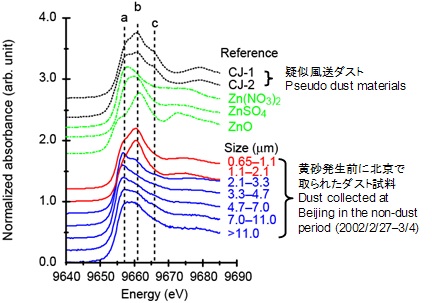last update 2016.04.23
ADEC (Aeolian Dust Experiment on Climate
impact) / Group of observation network (G2)
(The project was completed in March 2005)
Review of this project: Mikami et al. (2006) Aeolian dust experiment on climate impact: An overview of Japan–China joint project ADEC. Global and Planetary Change, 52(1–4), 142–172.
Aeolian dust is transported from the arid or semi-arid region in East Asia to Japan during spring (we called "Kosa"). It has large influences on life, agriculture and traffic, and more serious effects on the global climate. To investigate the impact of aeolian dust on the climate, Japan-China joint project (Aeolian Dust Experiment on Climate impact: ADEC) started in April 2000 with a five-year plan. We collected aeolian dust samples using high volume air sampler and Andersen-type low volume air sampler at China stations (Beijing, Hofei and Qingdao) and Japanese stations (Naha, Fukuoka, Nagoya and Tsukuba). Group of observation network (G2) studies of aeolian dust from the point of view of grain-size distribution, morphological properties, mineralogical and chemical compositions. Investigation of physical and chemical properties of aeolian dust.
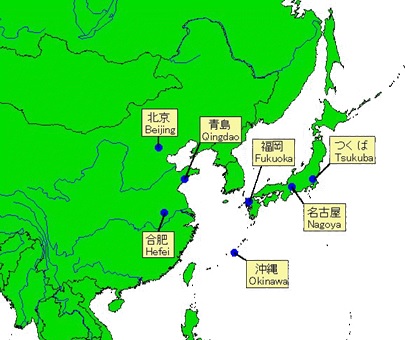
Observation stations
Geological Survey of japan, AIST has determined many elemental concentrations of aeolian dust.
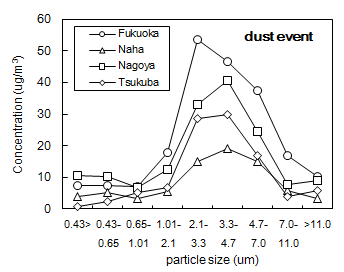
Grain-size distributions of aeolian dust
collected in Japan during March-April 2002.
In dust period, the concentrations of coarse particles (2.1-7.0 μm) increase. They are composed mainly of mineral aerosol. They are transported from inner-China to Japan within a few days. In non-dust period, coarse particles are originated from soil substances uplifting from the surrounding land and fine particles (< 1 μm) are composed of aggregated molecules of ammonium sulfate and carbon particles. [Kanai et al., 2005. J. Meteror. Soc. Japan, 83A, 73-106]
In the dust events, total dust concentrations were extremely high and the mass concentrations in coarse particles of > 2.1 μm were markedly increased at the Beijing stations.
Distribution of aerosol concentrations among particle size
(μg/m3).
Dust event was observed in 2002/03/19-21 and 2002/04/08.
Al2O3 and T-Fe2O3 concentrations are high in the coarse particles. Their size distribution patterns are consistent with those of dust concentrations. Their size distribution reflects the input of the uplifting mineral aerosols. In contrast, heavy metals such as Cu, Zn, and Pb are highly enriched in the fine particles. The distribution reflects the input of anthropogenic materials around the observation station. [Ohta et al., 2005. Bull. Geol. Surv. Japan, 56, 259-272.]
Distribution of elemental concentrations in aeolian dust samples against the
particle size.
Distribution of aerosol mass concentrations and that of Al2O3 and T-Fe2O3 concentrations in dust samples at Fukuoka station in Japan. Dust event was observed during 2002/04/06-11. In the dust period, the concentration of dust particles with 1–3 μm was increased remarkably, but the concentration of coarse particles (> 5 μm) was much smaller than those at Beijing station. The coarser particle would be effectively fell out during the transportation. Most elements including Al2O3 and T-Fe2O3 are abundant in the coarse particles and their distribution patterns are consistent with the size-segregated measurements of aeolian dust. The observation suggests that most elements originate in mineral aerosols. [Ohta et al., 2003. Bull. Geol. Surv. Japan, 54, 303-322.]
Distribution of aerosol concentrations and Al2O3
and T-Fe2O3
contents in dust samples against the particle size.
We elucidated that photo-reduction of Fe in aeolian dust might occur during the long transportation from China to Japan as Martin and Fitzwater (1988); Faust and Hoigné (1990); Zhuang et al. (1992); Zhu et al. (1993) suggested. Thus, valence states of Fe and Mn in aeolian dust collected from China (Beijing) and Japan (Fukuoka) stations were examined using an X-ray absorption near-edge structure (XANES) spectroscopy method.
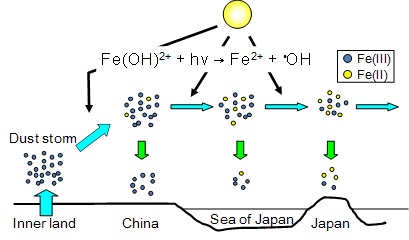
The XANES spectra of Fe in aeolian dust samples collected at Beijing and Fukuoka stations are resembling mutually. The spectra suggests that Fe dominantly exists as trivalent state in aeolian dust (Fe(III)/total Fe = 0.93–1.0). The fact indicates that the oxidation-reduction process of Fe in aeolian dust the transporting over the Sea of Japan to be negligible. [Ohta et al., 2006. Geochem. J., 40 363-376.]
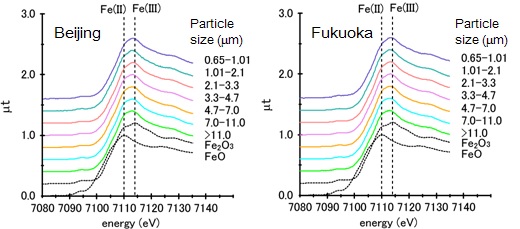
Alternatively, XANES spectroscopy is useful to estimate the anthropogenic contamination of aeolian dust. The XANES spectra of Zn in aeolian dust collected at the Beijing station during the non-dust period are explained by the mixtures of mineral phase and Zn(NO3)2 or ZnSO4. The fraction of Zn(NO3)2 and ZnSO4 are high in coarse particle (> 2.1 μm) and fine particles (<2.1 μm), respectively. We assumed that NO3− and SO42− released as pollutants from vehicle exhaust and industry would react with Zn in aerosols to form Zn(NO3)2 and ZnSO4. The proportions of these anthropogenic materials increase from 40% to 80% with decreasing the particle size. In dust period, however, Zn in aeolian dust is dominantly composed of the mineral aerosol. Aeolian dust transported from the arid or semi-arid region in East Asia would conceal the contribution of anthropogenic materials. [Ohta et al., 2006. Geochem. J., 40 363-376.]
